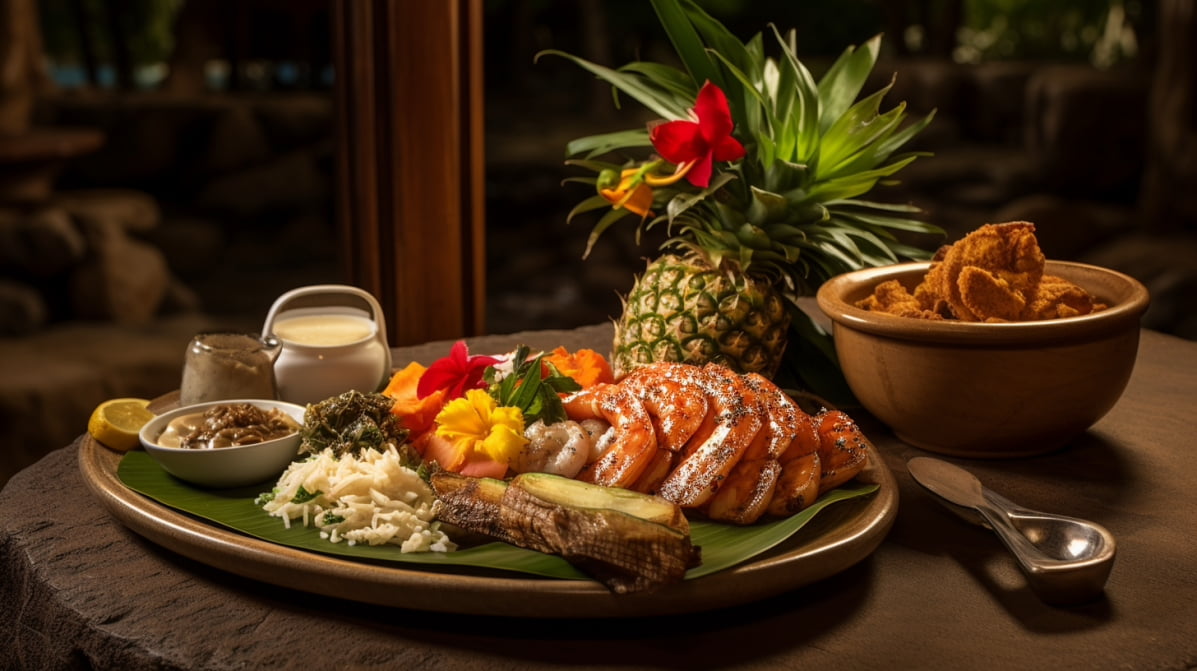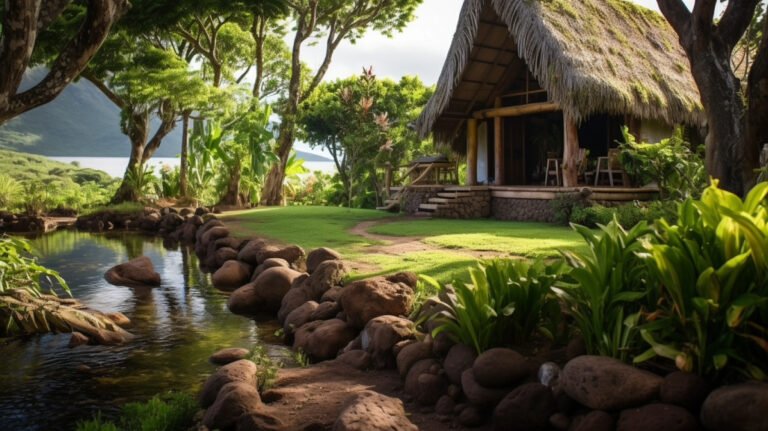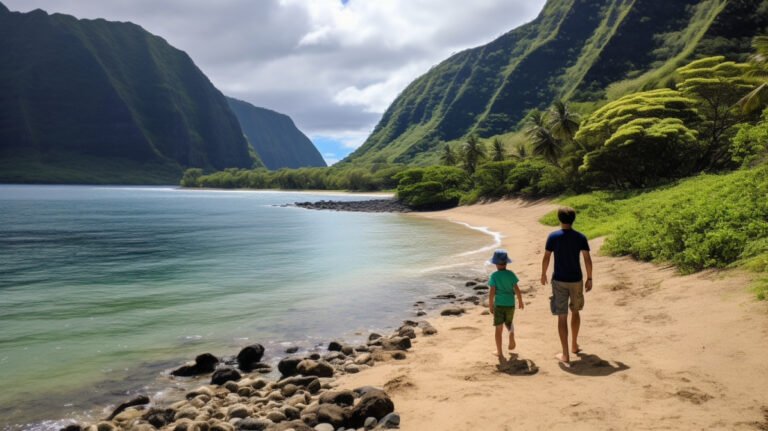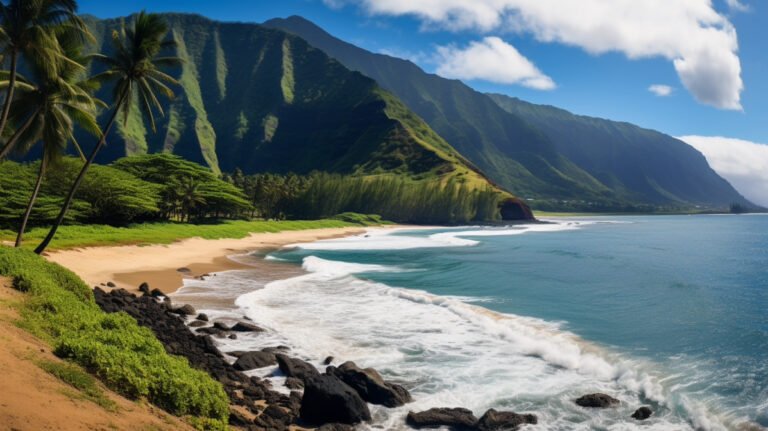Uncovering the Flavors 🌺🍍🌴: A Culinary Journey Through Molokai’s Hidden Treasures
When it comes to Hawaiian delicacies, Molokai Cuisine stands out with its unique flavors and cultural significance. Molokai is a small island in Hawaii that has managed to preserve its culinary heritage and offer a gastronomic experience like no other.
The local food scene in Molokai is a hidden treasure waiting to be discovered. From traditional dishes to fusion cuisine, the island’s culinary offerings are a reflection of its rich history and diverse influences.
Key Takeaways:
- Molokai Cuisine is unique in Hawaiian gastronomy.
- The local food scene in Molokai is a hidden treasure.
- Molokai’s culinary offerings reflect the island’s rich history and diverse influences.
Uncovering the Flavors of Molokai Cuisine
Molokai Cuisine is a melting pot of diverse cultural influences that have combined to create a unique and flavorful gastronomic experience. From traditional Hawaiian dishes to locally sourced seafood and freshly grown produce, the island’s cuisine offers a range of delicious and distinctive flavors.
Must-Try Molokai Recipes
One must-try dish is the traditional Hawaiian poke made with fresh ahi tuna, soy sauce, green onions, sesame oil, and chili flakes. Another famous dish in Molokai is the Kalua pork, slow-cooked in an imu (underground oven) for a tender and juicy texture. For something sweeter, try the haupia, a creamy coconut dessert that is a popular staple at Hawaiian luaus.
Other dishes to try include the laulau, a savory dish of pork and fish wrapped in luau leaves, and the pipi kaula, a salty and savory beef jerky that is marinated in soy sauce, ginger, and garlic.
Overall, Molokai Cuisine offers a range of unique and delicious dishes that are not to be missed. Whether you’re a foodie or simply looking to explore the island’s culinary scene, there’s something for everyone to enjoy.
The Cultural Significance of Molokai Food
Food is an integral part of the culture of Molokai, reflecting the island’s multi-ethnic heritage and unique way of life. The cuisine of Molokai is deeply rooted in the traditions and values of its people, and the island’s food scene is considered one of the most authentic in all of Hawaii. Many of the dishes are prepared using age-old techniques that have been passed down through generations, making Molokai Cuisine a true reflection of the island’s culinary heritage.
Exploring the Island Flavors of Molokai
Molokai Cuisine boasts unique island flavors that reflect its rich cultural heritage and abundant natural resources. The dishes are made from fresh local ingredients, ensuring that every bite is bursting with flavor. Here are some famous dishes that exemplify the island’s flavors:
| Dish | Ingredients | Description |
|---|---|---|
| Kalua Pork | Pork Shoulder, Sea Salt, Banana Leaves | A traditional dish where the pork is slow-roasted in an underground oven, giving it a smoky and tender taste. |
| Poi | Taro, Water | A starchy and slightly sweet dish made from mashed taro root, a staple crop in Molokai. |
These dishes are just a small sample of the many flavors that can be found in Molokai Cuisine. Exploring the island’s food scene will uncover a wealth of culinary treasures waiting to be tasted.
The Culinary Heritage of Molokai
Molokai’s culinary heritage is as rich and diverse as its history. The island’s food culture reflects the traditions and values of its people, who have lived off the land and sea for generations.
At the heart of Molokai Cuisine are the traditional dishes that have been passed down through families and communities. These dishes are a reflection of the island’s history and cultural influences.
Molokai is known for its taro plantations, which have been cultivated for centuries. Taro is a staple ingredient in many traditional Molokai dishes, including poi, which is a thick, starchy paste made from cooked and mashed taro. Other traditional dishes include laulau, which is pork or fish wrapped in taro leaves and cooked in an underground oven, and kalua pig, which is slow-roasted and traditionally served at luaus and other celebrations.
The island’s culinary heritage also includes dishes influenced by the cultures of the immigrants who came to Molokai to work on the plantations. Japanese, Filipino, and Portuguese cuisines have all contributed to the diverse flavors of Molokai Cuisine.
Today, Molokai residents are working to preserve and celebrate their food culture. The Molokai Agricultural Festival, held annually in April, showcases local food, farming, and sustainability. The festival features cooking demonstrations, tastings, and educational workshops that highlight the island’s culinary heritage.
Local Ingredients and Sustainability
Molokai Cuisine is known for its use of fresh, locally sourced ingredients. The island’s rich volcanic soil and tropical climate provide the perfect conditions for growing a variety of fruits, vegetables, and herbs. Many of the dishes found in Molokai draw on these local ingredients, highlighting their unique flavors and textures.
As sustainability becomes an increasingly important concern in the food industry, Molokai is leading the way with its eco-friendly practices. Many restaurants and food businesses on the island prioritize the use of sustainable ingredients and packaging, reducing waste and minimizing their ecological footprint. Visitors can feel good knowing that they are supporting a food scene that is committed to environmental responsibility.
Traditional Cooking Techniques
The traditional cooking techniques used in Molokai Cuisine have been passed down through generations and are an essential part of the island’s culinary heritage. These techniques contribute to the authenticity of the dishes and ensure that they are prepared in the traditional Molokai way.
One of the traditional cooking techniques used in Molokai is imu cooking, which involves cooking food in an underground oven called an imu. This method of cooking is often used for special occasions and is a popular way to prepare kalua pig, a beloved dish in Hawaiian cuisine. The pig is wrapped in ti leaves and cooked in the imu for several hours, resulting in a tender and juicy meat.
Hinalea Salt
Hinalea salt is another important element in traditional Molokai cooking. It is a type of sea salt that is harvested from shallow ponds in the ocean and is considered a delicacy in Hawaiian cuisine. The salt is hand-harvested by Molokai residents, who use traditional techniques to preserve its quality.
Another cooking technique that is commonly used in Molokai is lau hala basket cooking. This involves wrapping food in lau hala, or pandanus leaves, and then cooking it over hot coals. The leaves impart a unique flavor to the food and help to keep it moist while cooking.
The traditional cooking techniques used in Molokai reflect the island’s deep connection to its cultural heritage. By preserving these techniques and passing them down through generations, Molokai residents ensure that their culinary traditions will continue to thrive for years to come.
Molokai Cuisine: A Fusion of Cultures
Molokai Cuisine is a reflection of the island’s diverse cultural influences. The fusion of Polynesian, Japanese, Filipino, and Portuguese culinary traditions has created a unique gastronomic experience that highlights the flavors and ingredients of each culture.
The traditional Hawaiian cooking methods of imu (underground oven) and laulau (meat or fish wrapped in taro leaves) are commonly seen in Molokai dishes. Japanese influences can be found in the use of miso, soy sauce, and tempura batter. Filipino cuisine is represented in dishes like adobo and lumpia, while Portuguese sausage and sweet bread are popular breakfast items.
The Local Favorites
One of the best examples of Molokai’s fusion cuisine is the plate lunch, commonly found in local diners and food trucks. The plate lunch typically consists of a protein, such as teriyaki chicken or kalua pig, two scoops of rice, and macaroni salad.
Another must-try dish is the beef stew, which is often made with oxtail and served with rice or poi, a traditional Hawaiian staple made from taro root. Coconut milk, ginger, and other spices add a unique flavor to this hearty dish.
For seafood lovers, the poke bowl is a must-try. This raw fish salad is typically made with ahi tuna, soy sauce, onions, and sesame oil. It can be served as an appetizer or a main course with a side of rice.
A Cultural Experience
Molokai Cuisine is not only about the flavors and ingredients – it’s also a cultural experience. Many local restaurants and food markets promote the island’s culinary heritage and offer a chance to learn about the traditions and values that shape the cuisine.
Visitors can explore the Molokai Food Tour, which takes them to local farms, markets, and restaurants to taste the island’s unique flavors and learn about its sustainable and eco-friendly practices. They can also attend the annual Molokai Ka Hula Piko festival, where food vendors offer traditional Hawaiian dishes and refreshments.
Exploring Molokai’s food scene is an opportunity to not only satisfy your taste buds but to also learn about the island’s rich history and cultural diversity.
Must-Try Molokai Dishes
Visitors to Molokai should not miss the chance to sample the island’s unique and flavorful dishes. Here are some must-try Molokai recipes:
- Pipi Kaula – Also known as Hawaiian beef jerky. This dish is made by marinating thin strips of beef in soy sauce, sugar, and spices, then drying them out in the sun.
- Kalua Pig – One of the most famous dishes in Hawaii, Kalua Pig is made by slow-cooking a whole pig in an underground oven called an imu.
- Squid Luau – Tender pieces of squid cooked in coconut milk and taro leaves. It’s a delicious and savory dish that’s popular among locals.
- Manju – A type of Japanese pastry that’s filled with sweet red bean paste. Molokai is known for its delicious and authentic manju.
These dishes are just a few examples of the unique flavors and ingredients that make up Molokai Cuisine. Don’t be afraid to try something new and adventurous during your visit.
Exploring Molokai’s Food Scene
One of the best ways to experience Molokai Cuisine is by exploring the island’s local food scene. From farm-to-table restaurants to unique food festivals, there are plenty of opportunities to taste the authentic flavors of the island.
For a taste of traditional Molokai dishes, head to local eateries like Napili Cafe and Bakery and Kualapu’u Cookhouse. Both serve up classic favorites like poi, kalua pork, and lomi salmon.
For a more adventurous food experience, check out the weekly Saturday Farmers Market at the town of Kaunakakai. Here, you can sample locally grown produce, fresh seafood, and homemade baked goods.
If you happen to be on the island during the Molokai Ka Hula Piko festival, be sure to attend the Taste of Molokai event. This celebration of local food and culture features traditional Hawaiian music and dance performances, as well as food booths serving up Molokai delicacies.
By exploring Molokai’s food scene, you’ll gain a deeper appreciation for the island’s rich culinary heritage and the flavors that make it a hidden gem in Hawaiian gastronomy.
Preserving Molokai Cuisine for Future Generations
Molokai’s culinary heritage is a treasure trove of unique flavors and cultural influences that have been passed down through generations. To ensure that these traditions continue to thrive, efforts are underway to promote and protect the island’s authentic cuisine.
One such effort is the Molokai Food Hub, a non-profit organization dedicated to supporting local farmers and food producers and promoting sustainable agriculture. The Food Hub offers a range of services, including distribution, marketing, and education, to help ensure that Molokai’s agricultural community remains strong and vibrant.
Another important initiative is the annual Molokai 2 Oahu Paddleboard World Championships, which showcases the island’s rich cultural heritage and promotes sustainable practices in the food and agriculture sectors. In addition to the race, the event features a food and culture festival that celebrates the island’s diverse culinary traditions and showcases local food producers.
By supporting these and other initiatives, we can help ensure that Molokai’s unique cuisine continues to thrive for generations to come.
Discover the Hidden Treasures of Molokai Cuisine
Molokai Cuisine offers a unique and flavorful gastronomic experience that reflects the island’s history, culture, and natural resources. From the local food scene to traditional cooking techniques, Molokai has much to offer food enthusiasts.
If you’re planning a trip to Molokai, don’t miss the opportunity to explore the island’s diverse culinary offerings. Taste traditional Molokai dishes that have been passed down through generations and savor the fusion of different culinary traditions that have shaped the island’s cuisine.
Take a Culinary Journey through Molokai
Molokai has a variety of restaurants, markets, and food events that can satisfy your craving for local delicacies. Discover the must-try dishes, such as the Hawaiian Poi, Kalua Pork, and Poke, which are famous for their unique flavors and ingredients.
Don’t forget to try the local desserts, such as Haupia, a coconut milk-based pudding, and Malasadas, a Portuguese sweet fried bread. These dishes will give you a taste of the island’s culinary heritage and its fusion of cultures.
Preserving the Authentic Flavors of Molokai Cuisine
Molokai’s culinary heritage is an important part of the island’s culture and identity. Efforts are being made to promote and protect the island’s culinary traditions, ensuring that future generations can enjoy the unique flavors of Molokai cuisine.
By supporting local farmers, producers, and restaurants, you can contribute to the sustainability of the island’s food scene and help preserve its authentic flavors.
Embark on a culinary journey to Molokai and taste the hidden treasures of the island’s food scene. You’ll discover the unique tastes and traditions that make Molokai Cuisine a true delight.
Conclusion
Molokai’s culinary landscape is a delightful blend of traditional Hawaiian flavors and influences from various cultures. The island’s commitment to preserving its rich culinary heritage, combined with the use of fresh, locally-sourced ingredients, offers a gastronomic experience that is both authentic and unique. From traditional dishes like Kalua Pork and Poi to fusion delights influenced by Japanese, Filipino, and Portuguese cuisines, Molokai’s food scene is a testament to its diverse cultural tapestry. As you embark on your journey through Molokai, let your taste buds explore the myriad flavors that this island paradise has to offer.







